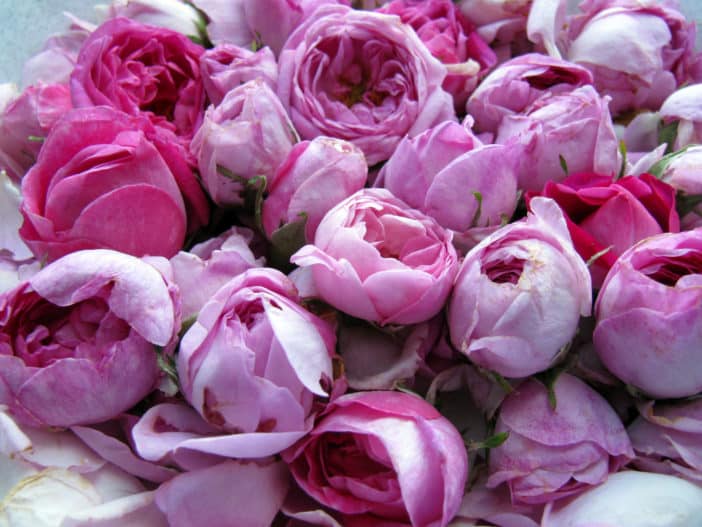Rose wax

Rose wax is the wafer-thin layer of wax found on the petals of Rosa damascena and, in small amounts, on Rosa centifolia. The plants use the wax to protect their sensitive petals from drying out. It is only ever available in very small quantities per plant and is therefore very precious and rare.
A valuable treasure from nature
The Rosa damascena, or Damask rose, originally comes from Asia Minor, its beguiling fragrance has been described in many fairy tales from 1001 Nights and is still one of the most important oriental fragrances. Rosa centifolia originated from a cross between Rosa damascena, Rosa gallica, Rosa moschata and Rosa canina. It too is known for its unique sweet fragrance.
Rose wax exudes the intense and beguiling scent of the flowers on the one hand, but also contains some earthy-herbaceous components on the other, which enlivens the fragrance experience in a unique way. The precious Rose wax can be excellently incorporated into cosmetic products. It is often used in creams, body lotions, lip and hair care products.
This wax has a protective and nurturing effect on the skin. Rose wax also takes on the function of preserving the plant’s own moisture, which is essential for survival, in care products: It covers the skin like a wafer-thin, protective, light and water-repellent film and protects against water loss. On the other hand, Rose wax gives hair a unique shimmering shine.
The consistency of Rose wax is somewhat reminiscent of shea butter. As it is a purely natural product, the colours can vary: from yellow-greenish-brownish to orange-reddish-brownish.
Rose wax in cosmetics
As a very high-quality alternative to the classic beeswax as a consistency agent and gives cosmetic products a touch of luxury and exclusivity. Together with jojoba oil and other natural ingredients, it forms the basis for enchanting scented ointments. With other essential oils such as ylang-ylang, citronella or neroli, you can create very individual fine fragrances. Thanks to its pleasantly semi-soft consistency, this wax is relatively easy to work with; the melting point is around 60 degrees Celsius. The concentration of Rose wax (INCI: Rosa Multiflora Flower Wax) varies greatly depending on the product. In scented ointments and perfumes, it is between 30 and 70 percent, in soaps about 20 percent and in hair conditioners and treatments to improve combability and shine between 0.1 and 0.5 percent.
At Cosmacon we develop beautiful and fragrant cosmetics for you with rose wax. For our formulations, we only use first-class pure rose wax from nature, which does not contain any additives. With these formulations, you can offer your target group exceptionally high-quality and luxurious products that are of the highest quality.
We love to work with these Rose wax – containing raw materials:
| Name | Supplier | INCI Name | Remarks |
|---|---|---|---|
| KahlWax 6692 Rose | Kahl GmbH & Co. KG | Rosa Damascena Flower Cera | |
| Ros Wax | Hammonia Oleochemicals GmbH | Rosa Multiflora Flower Wax | |
| Unipure White LC 981 NFW R CF | SENSIENT BEAUTY | CI 77891 , Rosa Centifolia Flower Wax , Rosa Damascena Flower Wax , Cera Alba | |
| Unipure Red LC 381 NFW R CF | SENSIENT BEAUTY | CI 77491 , Rosa Centifolia Flower Wax , Rosa Damascena Flower Wax , Cera Alba | |
| Unipure Black LC 989 NFW R CF | SENSIENT BEAUTY | CI 77499 , Rosa Centifolia Flower Wax , Rosa Damascena Flower Wax , Cera Alba | |
| Unipure Yellow LC 182 NFW R CF | SENSIENT BEAUTY | CI 77492 , Rosa Centifolia Flower Wax , Rosa Damascena Flower Wax , Cera Alba |
A touch of luxury and elegance
Cosmetics with rose wax not only have caring properties, but also inspire with a dreamlike fragrance experience at the same time. The so rare and precious rose wax, which protects the delicate rose blossoms from drying out, can be used in various products, where it provides a very noble note that pampers the senses. We at Cosmacon would be happy to develop sophisticated formulations for you with pure and very high-quality rose wax. Trust our experience. Feel free to ask us!
Literature:
Rose Flowers-A Delicate Perfume or a Natural Healer?
Mileva M, Ilieva Y, Jovtchev G, Gateva S, Zaharieva MM, Georgieva A, Dimitrova L, Dobreva A, Angelova T, Vilhelmova-Ilieva N, Valcheva V, Najdenski H.Biomolecules. 2021 Jan 19;11(1):127
Influence of Rosa damascena hydrosol on skin flora (contact culture) after hand-rubbing.
Bayhan GI, Gumus T, Alan B, Savas IK, Cam SA, Sahin EA, Arslan SO.GMS Hyg Infect Control. 2020 Sep 7;15:Doc21
Antioxidation and active constituents analysis of flower residue of Rosa damascena.
Liu WY, Chen LY, Huang YY, Fu L, Song LY, Wang YY, Bai Z, Meng FF, Bi YF.Chin Herb Med. 2020 Jul 11;12(3):336-341
Androutsopoulou C, Christopoulou SD, Hahalis P, Kotsalou C, Lamari FN, Vantarakis A.Pathogens. 2021 Apr 19;10(4):494